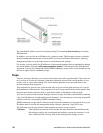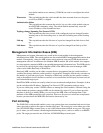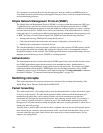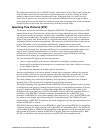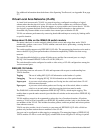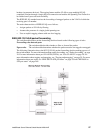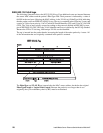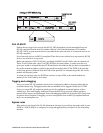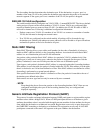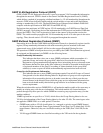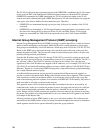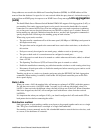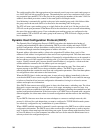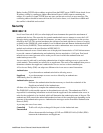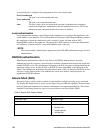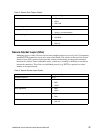30 Intel® Blade Server Ethernet Switch Module IXM5414E
The forwarding function determines the destination port. If the destination, or egress, port is a
member of the same VLAN as the packet the destination port transmits the packet on its attached
network segment. If the egress port is not a member of the VLAN, the packet is dropped.
IEEE 802.1Q VLAN configuration
The switch module initially configures one VLAN (VID = 1) named DEFAULT. The factory default
setting assigns all ports on the switch module to VLAN I. As new VLANs are configured, their
respective member ports are removed from VLAN 1. In addition, the VLAN ID value of 4095 is
reserved for internal use. Following is additional configuration information:
• Packets cannot cross VLANs. If a member of one VLAN is to connect to a member of another
VLAN, the link must be through an external router.
• If no VLANs are configured on the switch module, all packets will be forwarded to any
destination port. Packets with unknown source addresses will be flooded to all ports. Broadcast
and multicast packets will also be flooded to all ports.
Static MAC filtering
Static MAC Filtering allows you to add a small number (in the order of hundreds) of unicast or
multicast MAC addresses directly to the forwarding database. Associated with each Static MAC
address is a set of destination ports and VLAN information.
Any packet with a particular Static MAC Address in a particular VLAN is admitted only if the
ingress port is in the set of source ports, otherwise the packet is dropped. On the egress side the
packet, if admitted, is sent out of all the ports that are in the set of destination ports.
Upon ingress, each packet's destination MAC address is compared against the forwarding database.
If the address is not in the table, the packet is flooded within the VLAN. If the address is in the table,
then it is checked to see if it has been defined as a filter. If the MAC address is not defined as a filter,
forwarding is performed as a normal parced address.
If the specific destination MAC address is defined as a filter, the packet is forwarded to the set of
destination ports defined in the filter.
Static entries are never aged and can only be removed by user command.
/ NOTE
Even though the above discussion pertains to the forwarding database, MAC filters are not
configured and displayed as part of the forwarding database; they are configured and
displayed separately.
Generic Attribute Registration Protocol (GARP)
This protocol is used to exchange information between GARP participants to register and de-register
attribute values within a bridged LAN. When a GARP participant declares or withdraws a given
attribute, the attribute value is recorded with the applicant state machine for that attribute for the port
from which the declaration or withdrawal was made. Registration occurs only on ports that receive
the GARP PDU containing a declaration or withdrawal. De-registration occurs only if all GARP
participants connected to the same LAN segment as the port withdraw the declaration.



